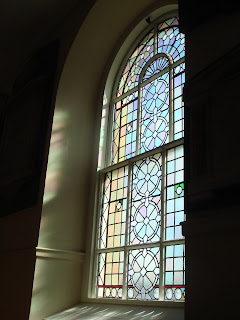
Here's a joyful poem in praise of the Nativity by the wonderful fifteenth-century Scottish poet
William Dunbar. In
The Oxford Book of Carols the poem is set to
this traditional tune, though I've never quite worked out to my own satisfaction how words and tune fit together...
Rorate coeli desuper,
Hevins, distil your balmy schouris;
For now is risen the bricht day-ster,
Fro the rose Mary, flour of flouris:
The cleir Sone, quhom no cloud devouris,
Surmounting Phebus in the Est,
Is cumin of his hevinly touris:
Et nobis Puer natus est.
Archangellis, angellis, and dompnationis,
Tronis, potestatis, and marteiris seir,
And all ye hevinly operationis,
Ster, planeit, firmament, and spheir,
Fire, erd, air, and water cleir,
To Him gife loving, most and lest,
That come in to so meik maneir;
Et nobis Puer natus est.
Synnaris be glad, and penance do,
And thank your Maker hairtfully;
For he that ye micht nocht come to
To you is cumin full humbly
Your soulis with his blood to buy
And loose you of the fiendis arrest--
And only of his own mercy;
Pro nobis Puer natus est.
All clergy do to him inclyne,
And bow unto that bairn benyng,
And do your observance divyne
To him that is of kingis King:
Encense his altar, read and sing
In holy kirk, with mind degest,
Him honouring attour all thing
Qui nobis Puer natus est.
Celestial foulis in the air,
Sing with your nottis upon hicht,
In firthis and in forrestis fair
Be myrthful now at all your mycht;
For passit is your dully nicht,
Aurora has the cloudis perst,
The Sone is risen with glaidsum licht,
Et nobis Puer natus est.
Now spring up flouris fra the rute,
Revert you upward naturaly,
In honour of the blissit frute
That raiss up fro the rose Mary;
Lay out your levis lustily,
Fro deid take life now at the lest
In wirschip of that Prince worthy
Qui nobis Puer natus est.
Sing, hevin imperial, most of hicht!
Regions of air mak armony!
All fish in flud and fowl of flicht
Be mirthful and mak melody!
All Gloria in excelsis cry!
Heaven, erd, se, man, bird, and best,--
He that is crownit abone the sky
Pro nobis Puer natus est!
Dunbar's Scots is fairly readable, but just in case:
Rorate coeli desuper,
Heavens, distill your balmy showers;
For now is risen the bright daystar,
From the rose Mary, flower of flowers!
The clear Son, whom no cloud devours,
Surmounting Phoebus in the East,
Is come down from his heavenly towers:
Et nobis Puer natus est.
Archangels, angels, and dominations,
[dominions]
Thrones, potestates, and martyrs sere,
[many]
And all ye heavenly operations,
Star, planet, firmament, and sphere,
Fire, earth, air, and water clear,
To Him give praise, most and least,
Who comes in such a meek manner;
Et nobis Puer natus est.
Sinners be glad, and penance do,
And thank your Maker heartfully;
For he that ye could not come unto
To you is come full humbly,
Your souls with his blood to buy
And loose you of the fiend's arrest -
And only of his own mercy;
Pro nobis Puer natus est.
All clergy do to him incline,
And bow unto that bairn benign,
And do your observance divine
To him that is of kings King:
Incense his altar, read and sing
In holy kirk, with mind degest,
[well-composed]
Him honouring above all thing
Qui nobis Puer natus est.
Celestial fowls in the air,
Sing with your notes upon high,
In firths and in forests fair
Be mirthful now with all your might;
For passed is your dull night,
Aurora has the clouds pierced,
The Son is risen with gladsome light,
Et nobis Puer natus est.
Now spring up flowers from the root,
Revert you upward naturally,
In honour of the blessed fruit
That rose up from the rose Mary;
Lay out your leaves lustily,
From death take life now at the last
In worship of that Prince worthy
Qui nobis Puer natus est.
Sing, heaven imperial, most of height!
Regions of air make harmony!
All fish in flood and fowl in flight
Be mirthful and make melody!
All Gloria in excelsis cry!
Heaven, earth, sea, man, bird, and beast,
He that is crowned above the sky
Pro nobis Puer natus est!








































































